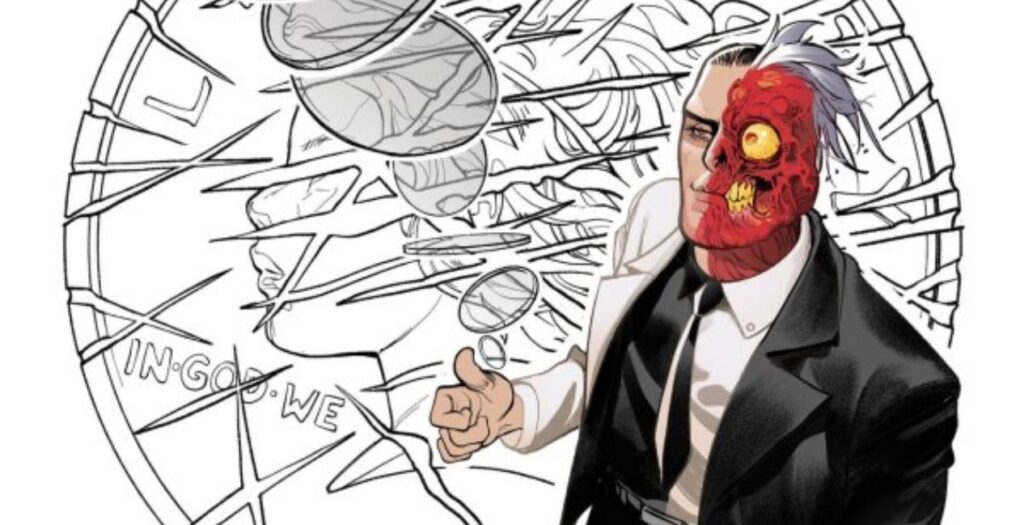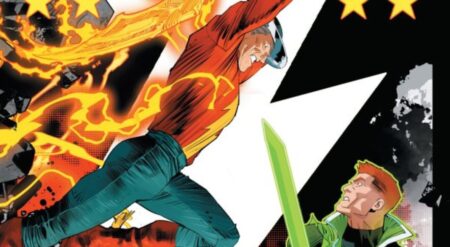Two-Face #1 is published by DC Comics. It is written by Christian Ward, art by Fábio Veras, colors by Ivan Plascencia, and letters by Hassan Otsmane-Elhaou. In the first issue, Two-Face carries out his own form of justice in the underworld of Gotham.
Taking place exclusively in the darkest and most dangerous part of Gotham City, there are no heroes to instill justice within the underworld. It falls to the villains to make their own rules and enforce them. The first half of Two-Face #1 is a court case in presentation alone. There is a court, an accused, a judge, and even a gavel. But it has been created by the criminals themselves. It is noisy and lively, with Dent struggling to maintain order over the rabble in front of him.
This is a court case with a surprising twist, using reputation to create assumptions. Ward crafts the scene’s drama and story excellently, quickly gathering all the necessary facts and executing it flawlessly. After that, Two-Face #1 starts to build Two-Face’s new territory, building the world and a new ecosystem for the gangs of Gotham. They must all follow the rules of the White Church, a code getting close to honor but not quite strong enough, and it falls to Two-Face to enforce it. Two-Face #1 is a noir gang comic with twisted law running through the heart of it.
The issue features one of the most unreliable narrators in comics. Two-Face has always been two people, opposite sides of the coin. But for the majority of Two-Face #1, it looks like Dent is the one in control. He is working his own form of justice and trying to do good. While he is climbing to the top of the underworld, his real goal is to go out and back to the heart of Gotham. However, there is also uncertainty and even an inevitability that the other side of Two-Face will appear.
That confidence from Harvey is enthralling but also dangerous, as it sets him up for an almighty fall. Ward relishes writing a book filled with villains. Each character is a gangster, serial killer, or any other form of criminal. The other recognisable figure in Two-Face #1 is Victor Zsasz, one of Gotham’s most reprehensible and bloodthirsty characters. Ward chooses a different path for Zsasz, which may be a brilliant red herring.
The art for Two-Face #1 is fascinating, beautifully fitting the tone of the comic. It is dark and mysterious for the bulk of the book, capturing the grittiness of the locations and the characters. There is always a way of telling which personality is in control of Two-Face at any particular time. Whichever part of his face is more visible is likely the more dominant voice. During the trial, where he has to provide detailed evidence to lead the room, Dent is the personality at the forefront. But when he gets nasty or violent, his scarred side takes over.
The violence and grim parts of the comic show what is necessary, not getting bogged down or excessive with details. This makes the brutality of the fight scenes and the murder investigations more profound and exciting, even when they are just silhouettes. What’s also impressive about characters like Two-Face and Zsasz is that they aren’t hulking, muscular monsters. Dent is tall in his suit, but both are slight and thin. And yet, they can still be insidious and terrifying.
The colors feature some remarkable contrasts. For 90% of Two-Face #1, a natural color palette sinks the issue into the bowels of Gotham City. What sticks out is Two-Face. The raw skin of his scars sticks out, as does the purple half of his suit. However, the issue is bookended by two vibrant and trippy scenes, as the conflict between the two personalities is at its highest. More surreal colors are used by Plascencia, like paint warping. In these moments, it is like the influence of the writer is breaking through on the art. It is the sequence seen in many of Ward’s comics, such as Batman: City of Madness.
Two-Face #1 toys with the two personalities. The story brilliantly shows the differences between Harvey Dent and Two-Face, co-habiting in the same body. Both the script and visuals are phenomenal, exploring a mindset on multiple levels. The issue has gritty realism on the streets of Gotham, followed by a more surreal battle on a cerebral plane. The change in art as that happens is fascinating and adds variety to the book. Ward’s magical writing style is translated superbly by Veras and Plascencia, turning the story into a mesmerising journey.
Two-Face #1 is available wherever comics are sold.
Two-Face #1 (2024)
-
Rating
TL;DR
Two-Face #1 toys with the two personalities. The story brilliantly shows the differences between Harvey Dent and Two-Face, co-habiting in the same body.







